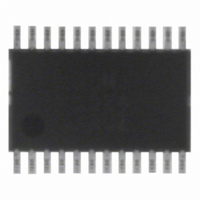ADM1024ARUZ ON Semiconductor, ADM1024ARUZ Datasheet - Page 13

ADM1024ARUZ
Manufacturer Part Number
ADM1024ARUZ
Description
IC MONITOR SYS TEMP/VOLT 24TSSOP
Manufacturer
ON Semiconductor
Datasheet
1.ADM1024ARUZ.pdf
(29 pages)
Specifications of ADM1024ARUZ
Applications
PC's, PDA's
Interface
Serial
Voltage - Supply
2.8 V ~ 5.5 V
Package / Case
24-TSSOP
Mounting Type
Surface Mount
Temperature Sensor Function
Temp Sensor
Output Type
Digital
Package Type
TSSOP
Operating Temperature (min)
0C
Operating Temperature (max)
100C
Operating Temperature Classification
Commercial
Operating Supply Voltage (typ)
3.3V
Operating Supply Voltage (max)
5.5V
Full Temp Accuracy
+/- 2 C , +/- 3 C
Digital Output - Bus Interface
SMBus
Digital Output - Number Of Bits
10 bit
Supply Voltage (max)
12 V
Supply Voltage (min)
2.5 V
Maximum Operating Temperature
+ 100 C
Minimum Operating Temperature
0 C
Supply Current
1.4 mA
Lead Free Status / RoHS Status
Lead free / RoHS Compliant
Available stocks
Company
Part Number
Manufacturer
Quantity
Price
Part Number:
ADM1024ARUZ
Manufacturer:
ADI/亚德诺
Quantity:
20 000
positive and negative temperatures can be measured, the
temperature data is stored in twos complement format, as
shown in Table 4. Theoretically, the temperature sensor and
ADC can measure temperatures from −128°C to +127°C
with a resolution of 1°C, although temperatures below
−40°C and above +125°C are outside the operating
temperature range of the device.
External Temperature Measurement
external diode sensors or diode−connected transistors,
connected to Pins 13 and 14 or 17 and 18.
Pins 17 and 18 can be configured to measure a diode sensor
by setting Bit 2 of the Channel Mode Register to 1.
transistor, operated at a constant current, exhibits a negative
temperature coefficient of about –2 mV/°C. Unfortunately,
the absolute value of V
individual calibration is required to null this out, so the
technique is unsuitable for mass production.
change in V
currents.
K is Boltzmann’s constant.
q is the charge on the carrier.
T is the absolute temperature in Kelvins.
N is the ratio of the two currents.
measure the output of an external temperature sensor. This
figure shows the external sensor as a substrate transistor
provided
microprocessors, but it could equally well be a discrete
transistor.
grounded and should be linked to the base. If a PNP
transistor is used, the base is connected to the D− input and
the emitter to the D+ input. If an NPN transistor is used, the
emitter is connected to the D− input and the base to the D+
input.
TRANSISTOR
The ADM1024 can measure the temperature of two
Pins 13 and 14 are a dedicated temperature input channel.
The forward voltage of a diode or diode−connected
The technique used in the ADM1024 is to measure the
This is given by:
Figure 17 shows the input signal conditioning used to
If a discrete transistor is used, the collector will not be
Figure 17. Signal Conditioning for External Diode
SENSING
REMOTE
where:
BE
for
D–
D+
DV
when the device is operated at two different
be
I
Temperature Sensors
temperature
+ KT q
DIODE
N y I
BE
BIAS
varies from device to device, and
I
BIAS
ln ( N )
LOW−PASS
f
C
FILTER
= 65kHz
LPF
monitoring
V
DD
on
(eq. 5)
http://onsemi.com
V
V
some
OUT+
OUT–
ADC
TO
13
measurement, the more negative terminal of the sensor is not
referenced to ground, but is biased above ground by an
internal diode at the D− input. As the sensor is operating in
a noisy environment, C1 is provided as a noise filter. See the
Layout Considerations section for more information on C1.
operating currents of I and N × I. The resulting waveform is
passed through a 65 kHz low−pass filter to remove noise,
then to a chopper−stabilized amplifier that performs the
functions of amplification and rectification of the waveform
to produce a dc voltage proportional to DV
is measured by the ADC to give a temperature output in
8−bit twos complement format. To further reduce the effects
of noise, digital filtering is performed by averaging the
results of 16 measurement cycles. An external temperature
measurement takes nominally 9.6 ms.
stored in 8−bit, twos complement format, as illustrated in
Table 4.
Layout Considerations
care must be taken to protect the analog inputs from noise,
particularly when measuring the very small voltages from a
remote diode sensor. The following precautions should be
taken:
Table 4. Temperature Data Format
To prevent ground noise from interfering with the
To measure DV
The results of external temperature measurements are
Digital boards can be electrically noisy environments, and
1. Place the ADM1024 as close as possible to the
2. Route the D+ and D− tracks close together, in
Temperature
remote sensing diode. Provided that the worst
noise sources such as clock generators,
data/address buses, and CRTs are avoided, this
distance can be 4 inches to 8 inches.
parallel, with grounded guard tracks on each side.
Provide a ground plane under the tracks if
possible.
+100°C
+125°C
+127°C
−128°C
−125°C
−100°C
+0.5°C
−75°C
−50°C
−25°C
+10°C
+25°C
+50°C
+75°C
0°C
BE
, the sensor is switched between
Digital Output
1000 0000
0000 0000
0000 0000
0000 1010
0001 1001
1000 0011
1001 1100
1011 0101
0011 0010
0100 1011
0110 0100
1100 1110
1110 0111
0111 1101
0111 1111
BE
. This voltage












